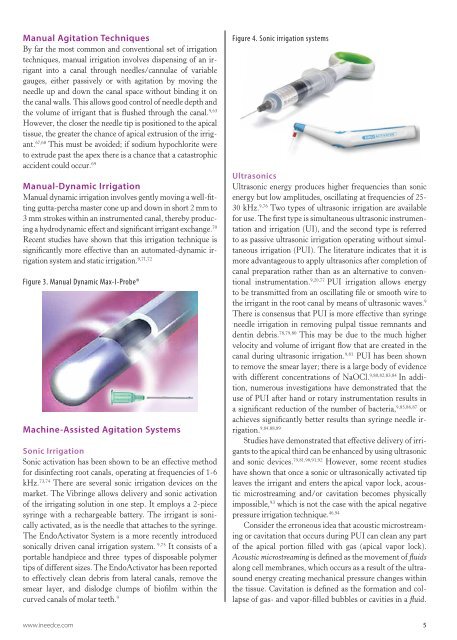Safety and Efficacy Considerations in Endodontic ... - IneedCE.com
Safety and Efficacy Considerations in Endodontic ... - IneedCE.com
Safety and Efficacy Considerations in Endodontic ... - IneedCE.com
You also want an ePaper? Increase the reach of your titles
YUMPU automatically turns print PDFs into web optimized ePapers that Google loves.
Manual Agitation Techniques<br />
By far the most <strong>com</strong>mon <strong>and</strong> conventional set of irrigation<br />
techniques, manual irrigation <strong>in</strong>volves dispens<strong>in</strong>g of an irrigant<br />
<strong>in</strong>to a canal through needles/cannulae of variable<br />
gauges, either passively or with agitation by mov<strong>in</strong>g the<br />
needle up <strong>and</strong> down the canal space without b<strong>in</strong>d<strong>in</strong>g it on<br />
the canal walls. This allows good control of needle depth <strong>and</strong><br />
the volume of irrigant that is flushed through the canal. 9,63<br />
However, the closer the needle tip is positioned to the apical<br />
tissue, the greater the chance of apical extrusion of the irrigant.<br />
67,68 This must be avoided; if sodium hypochlorite were<br />
to extrude past the apex there is a chance that a catastrophic<br />
accident could occur. 69<br />
Manual-Dynamic Irrigation<br />
Manual dynamic irrigation <strong>in</strong>volves gently mov<strong>in</strong>g a well-fitt<strong>in</strong>g<br />
gutta-percha master cone up <strong>and</strong> down <strong>in</strong> short 2 mm to<br />
3 mm strokes with<strong>in</strong> an <strong>in</strong>strumented canal, thereby produc<strong>in</strong>g<br />
a hydrodynamic effect <strong>and</strong> significant irrigant exchange. 70<br />
Recent studies have shown that this irrigation technique is<br />
significantly more effective than an automated-dynamic irrigation<br />
system <strong>and</strong> static irrigation. 9,71,72<br />
Figure 3. Manual Dynamic Max-I-Probe®<br />
Mach<strong>in</strong>e-Assisted Agitation Systems<br />
Sonic Irrigation<br />
Sonic activation has been shown to be an effective method<br />
for dis<strong>in</strong>fect<strong>in</strong>g root canals, operat<strong>in</strong>g at frequencies of 1-6<br />
kHz. 73,74 There are several sonic irrigation devices on the<br />
market. The Vibr<strong>in</strong>ge allows delivery <strong>and</strong> sonic activation<br />
of the irrigat<strong>in</strong>g solution <strong>in</strong> one step. It employs a 2-piece<br />
syr<strong>in</strong>ge with a rechargeable battery. The irrigant is sonically<br />
activated, as is the needle that attaches to the syr<strong>in</strong>ge.<br />
The EndoActivator System is a more recently <strong>in</strong>troduced<br />
sonically driven canal irrigation system. 9,75 It consists of a<br />
portable h<strong>and</strong>piece <strong>and</strong> three types of disposable polymer<br />
tips of different sizes. The EndoActivator has been reported<br />
to effectively clean debris from lateral canals, remove the<br />
smear layer, <strong>and</strong> dislodge clumps of biofilm with<strong>in</strong> the<br />
curved canals of molar teeth. 9<br />
Figure 4. Sonic irrigation systems<br />
Ultrasonics<br />
Ultrasonic energy produces higher frequencies than sonic<br />
energy but low amplitudes, oscillat<strong>in</strong>g at frequencies of 25-<br />
30 kHz. 9,76 Two types of ultrasonic irrigation are available<br />
for use. The first type is simultaneous ultrasonic <strong>in</strong>strumentation<br />
<strong>and</strong> irrigation (UI), <strong>and</strong> the second type is referred<br />
to as passive ultrasonic irrigation operat<strong>in</strong>g without simultaneous<br />
irrigation (PUI). The literature <strong>in</strong>dicates that it is<br />
more advantageous to apply ultrasonics after <strong>com</strong>pletion of<br />
canal preparation rather than as an alternative to conventional<br />
<strong>in</strong>strumentation. 9,20,77 PUI irrigation allows energy<br />
to be transmitted from an oscillat<strong>in</strong>g file or smooth wire to<br />
the irrigant <strong>in</strong> the root canal by means of ultrasonic waves. 9<br />
There is consensus that PUI is more effective than syr<strong>in</strong>ge<br />
. needle irrigation <strong>in</strong> remov<strong>in</strong>g pulpal tissue remnants <strong>and</strong><br />
dent<strong>in</strong> debris. 78,79,80 This may be due to the much higher<br />
velocity <strong>and</strong> volume of irrigant flow that are created <strong>in</strong> the<br />
canal dur<strong>in</strong>g ultrasonic irrigation. 9,81 PUI has been shown<br />
to remove the smear layer; there is a large body of evidence<br />
with different concentrations of NaOCl. 9,80,82,83,84 In addition,<br />
numerous <strong>in</strong>vestigations have demonstrated that the<br />
use of PUI after h<strong>and</strong> or rotary <strong>in</strong>strumentation results <strong>in</strong><br />
a significant reduction of the number of bacteria, 9,85,86,87 or<br />
achieves significantly better results than syr<strong>in</strong>ge needle irrigation.<br />
9,84,88,89<br />
Studies have demonstrated that effective delivery of irrigants<br />
to the apical third can be enhanced by us<strong>in</strong>g ultrasonic<br />
<strong>and</strong> sonic devices. 79,81,90,91,92 However, some recent studies<br />
have shown that once a sonic or ultrasonically activated tip<br />
leaves the irrigant <strong>and</strong> enters the apical vapor lock, acoustic<br />
microstream<strong>in</strong>g <strong>and</strong>/or cavitation be<strong>com</strong>es physically<br />
impossible, 93 which is not the case with the apical negative<br />
pressure irrigation technique. 46,94<br />
Consider the erroneous idea that acoustic microstream<strong>in</strong>g<br />
or cavitation that occurs dur<strong>in</strong>g PUI can clean any part<br />
of the apical portion filled with gas (apical vapor lock).<br />
Acoustic microstream<strong>in</strong>g is def<strong>in</strong>ed as the movement of fluids<br />
along cell membranes, which occurs as a result of the ultrasound<br />
energy creat<strong>in</strong>g mechanical pressure changes with<strong>in</strong><br />
the tissue. Cavitation is def<strong>in</strong>ed as the formation <strong>and</strong> collapse<br />
of gas- <strong>and</strong> vapor-filled bubbles or cavities <strong>in</strong> a fluid.<br />
www.<strong>in</strong>eedce.<strong>com</strong> 5

















